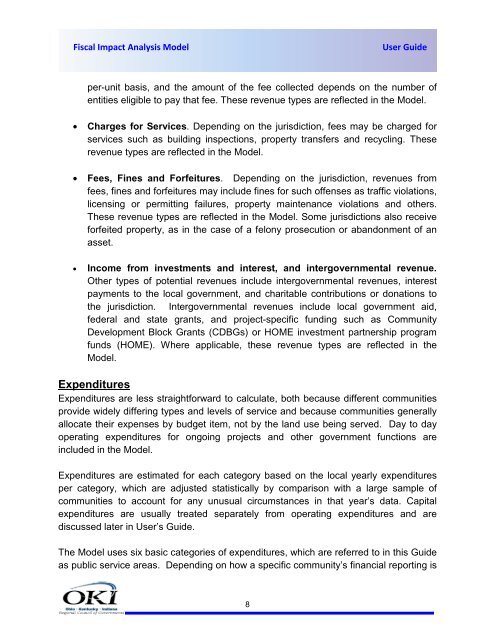FIAM USER GUIDE COVER II - Fiscal Impact Analysis Model - OKI
FIAM USER GUIDE COVER II - Fiscal Impact Analysis Model - OKI
FIAM USER GUIDE COVER II - Fiscal Impact Analysis Model - OKI
Create successful ePaper yourself
Turn your PDF publications into a flip-book with our unique Google optimized e-Paper software.
<strong>Fiscal</strong> <strong>Impact</strong> <strong>Analysis</strong> <strong>Model</strong><br />
User Guide<br />
per-unit basis, and the amount of the fee collected depends on the number of<br />
entities eligible to pay that fee. These revenue types are reflected in the <strong>Model</strong>.<br />
• Charges for Services. Depending on the jurisdiction, fees may be charged for<br />
services such as building inspections, property transfers and recycling. These<br />
revenue types are reflected in the <strong>Model</strong>.<br />
• Fees, Fines and Forfeitures. Depending on the jurisdiction, revenues from<br />
fees, fines and forfeitures may include fines for such offenses as traffic violations,<br />
licensing or permitting failures, property maintenance violations and others.<br />
These revenue types are reflected in the <strong>Model</strong>. Some jurisdictions also receive<br />
forfeited property, as in the case of a felony prosecution or abandonment of an<br />
asset.<br />
• Income from investments and interest, and intergovernmental revenue.<br />
Other types of potential revenues include intergovernmental revenues, interest<br />
payments to the local government, and charitable contributions or donations to<br />
the jurisdiction. Intergovernmental revenues include local government aid,<br />
federal and state grants, and project-specific funding such as Community<br />
Development Block Grants (CDBGs) or HOME investment partnership program<br />
funds (HOME). Where applicable, these revenue types are reflected in the<br />
<strong>Model</strong>.<br />
Expenditures<br />
Expenditures are less straightforward to calculate, both because different communities<br />
provide widely differing types and levels of service and because communities generally<br />
allocate their expenses by budget item, not by the land use being served. Day to day<br />
operating expenditures for ongoing projects and other government functions are<br />
included in the <strong>Model</strong>.<br />
Expenditures are estimated for each category based on the local yearly expenditures<br />
per category, which are adjusted statistically by comparison with a large sample of<br />
communities to account for any unusual circumstances in that year’s data. Capital<br />
expenditures are usually treated separately from operating expenditures and are<br />
discussed later in User’s Guide.<br />
The <strong>Model</strong> uses six basic categories of expenditures, which are referred to in this Guide<br />
as public service areas. Depending on how a specific community’s financial reporting is<br />
8
















